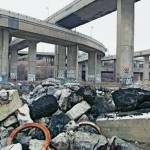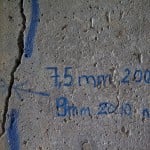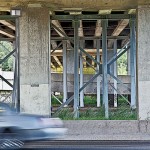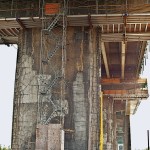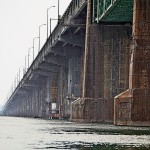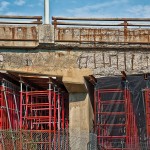Montreal is falling down
A history of bad design choices now haunts the city as its bridges, roads and tunnels crumble
Share

When a grapefruit-sized chunk of concrete smashed through the windshield of a 29-year-old man’s car in Montreal last Thursday, city officials quickly scrambled to the scene. Like most Montrealers, they assumed the worst—that it was yet another in a series of mishaps involving the city’s crumbling infrastructure. Their worries turned out to be misplaced. Within a few hours, police had eliminated the possibility that the object was once a part of the overpass above busy Papineau Avenue and were instead investigating whether someone had thrown it. “I want to reassure the people of Montreal: the rock that caused this incident has nothing to do with the structure,” Montreal Mayor Gérald Tremblay told reporters at the scene, deftly avoiding the very word “concrete.” “Vehicles can pass in total safety.” Still, it’s hard to blame even the most paranoid residents for assuming the contrary. It’s raining concrete in Montreal, it seems, and the situation has people on edge.
The most recent incident occurred in late July, when a 15-m long, 25-tonne chunk of concrete fell onto the busy Ville-Marie expressway in the city’s downtown core. Miraculously, no one was injured. (Transport Québec estimates 100,000 vehicles travel along the expressway daily.) Montrealers were no doubt shocked by the accident but, at this point, it may be a stretch to say they were surprised.
The accident was, after all, a grim reminder of a similar collapse in nearby Laval in 2006. Five people died and six more were seriously injured when the de la Concorde overpass came tumbling down onto cars travelling below. And the de la Concorde collapse was itself reminiscent of an incident in which eight heavy concrete beams fell from the Souvenir Boulevard overpass in Laval in 2000, killing one and injuring two others.
Since then, authorities in Quebec have had to shut down parts of two key bridges—the Mercier and the Champlain—to complete emergency repairs, as well as undertake separate emergency repairs on the city’s massive Turcot interchange after cracks were discovered on a ramp, and steel reinforcements were found to have been improperly installed when the Turcot was built in the 1960s. The interchange, a maze of concrete that links three major highways in downtown Montreal, had already been shedding concrete chunks for several years when the latest problems were uncovered. (The province unveiled plans earlier this year to rebuild the interchange entirely by 2018 at a cost of $3 billion.) A 2003 report for the provincial government by the engineering firm SNC-Lavallin found that chunks as big as one square metre were falling off the Turcot before mesh was added to keep them in place.
The same engineering firm similarly recommended in 2008 that Transport Québec perform a structural analysis of the section of the Viger tunnel that collapsed last month, finding that “its general state is critical as far as user safety is concerned.” Last week, provincial Transport Minister Sam Hamad promised to release reports on the state of the Mercier Bridge and the Turcot interchange “within weeks.” He had initially refused to do so, saying the public wouldn’t understand them. “The citizen wants to know, is the infrastructure safe?” Hamad told a reporter for the Montreal Gazette in June. “The answer is yes.”
All evidence to the contrary, just why is Montreal falling apart? “Our problem is we built most of the facilities in the ’60s and ’70s, built them in a hurry,” says McGill University’s Saeed Mirza, an expert on concrete infrastructure. “The result is that the quality control was not there.” The problem boils down to the ill-advised design choices and poor-quality concrete that were used in the rush to build up Montreal ahead of Expo ’67 and the 1976 Olympics, he says. “Our concrete is permeable and we didn’t design the drainage on our overpasses and bridges properly. The lack of drainage and the permeability of the concrete enabled the chlorides to get in from the de-icing salts. That, of course, led to the corrosion of the steel reinforcements. When steel corrodes, it expands. That pressure causes the weakest link to fail.” The result is a familiar sight to most Montrealers: cracked and crumbling concrete barely hiding the disintegrating steel bars inside.
As Mirza points out, the state of the Champlain bridge should be especially worrisome. As a so-called lifeline structure, it’s an integral component of the city’s transportation network. “It is expected to operate during and after any major catastrophe—earthquake, hurricane, you name it,” he says. “We need these bridges absolutely. We can’t let them fail. We are an island.”
The spate of accidents appears to have cemented the view that Montreal’s infrastructure is in terminal decline. In a recent online poll by Léger Marketing conducted shortly after the Viger tunnel collapse, a whopping 88 per cent of Montrealers said they are “worried” about the state of roads, bridges and tunnels in the city, with more than half of respondents saying they are downright “scared” to drive under an overpass (58 per cent), on a bridge (54 per cent), or through a tunnel (53 per cent). Officials now have a steep hill to climb before the public’s confidence is restored, says Mirza. That Montreal is crumbling “might have been a perception years ago,” he says. “Now it is a fact.”
Click on a thumbnail to enter the photo gallery:
